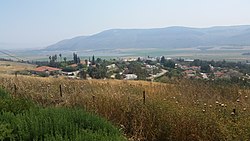 |
| courtesy Wikipedia |
Sites include:
Kumi Hill, in the northeast of the kibbutz, part of a hilly area covering the entire eastern border of both the kibbutz and Tel Yosef;
Ein Harod Ihud covers the northern half of Ein Harod. It was formed in 1952 over ideological differences with the southern half of the kibbutz and became part of the Ihud HaKvutzot v’HaKibbutzim movement;
Ein Harod Meuhad covers the southern half of Ein Harod. It was formed in 1952 over ideological differences with the northern half of the kibbutz and became part of the Kibbutz Meuhad movement;
Mishkan Le'omanut, one of the first art museums in Israel, founded by the early kibbutz members. It was inaugurated in 1948 and has on display, thousands of artwork collections and is home to many art shows throughout the year;
The Bet Shturman Museum contains collections of local human and natural history as well as local archaeological exhibits;
The Old Railroad Station, which is nothing more than a shed, served the Jezreel Valley railway during the British Mandate period;
Nahal Harod, an ancient stream from which, the Biblical town of Harod was named. It stretches from the Jordan River a few miles south of the Sea of Galilee, past Ein Harod on the south side where it waters several large fish ponds, and ends on the south side of Kfar Yehezkel;
Mount Gilboa, part of a mountain range that almost follows the course of Nahal Harod. It is the home of HaGilboa Nature Reserve;
Maayan Harod, today, an archaeological site that also contains an ancient amphitheater, lies a few miles west of Ein Harod between Kfar Yehezkel and Kibbutz Yizre’el.
No comments:
Post a Comment